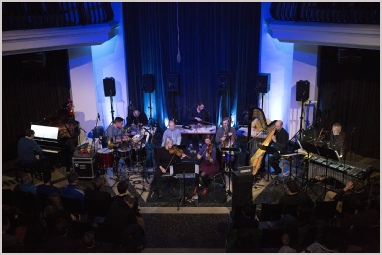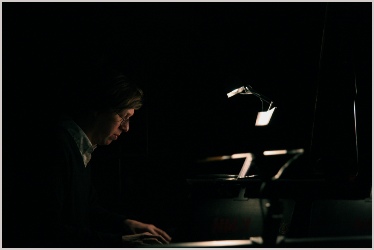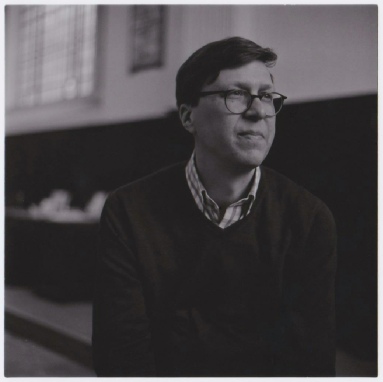Another Timbre TimHarrisonbre


at156 Magnus Granberg & Skogen
‘Let Pass My Weary Guiltless Ghost’
Magnus Granberg - prepared piano & composition
Ko Ishikawa - sho Anna Lindal - violin
Leo Svensson Sander - cello Simon Allen - vibraphone
Erik Carlsson - percussion Henrik Olsson - objects
Petter Wästberg - contact microphone, mixing board, loudspeaker
Jesse Goin interviews Magnus Granberg
This interview can also be read at the Crow With No Mouth website here
JG: It's striking to me how present and vital the organic (and sentient) is in your musical world -both in the descriptive language around your process of composition and , to my ears, in the sounds themselves; e.g., Skogen means forest, bombax is a species of tree, you refer to the fragments of source material you integrate into your pieces as 'pools', you describe the framing of a piece as 'environments', etc.
Then there are the sounds themselves- of course it's much more difficult to convey the organicity one hears in these environments, of their atmosphere- but it’s there nonetheless- so much so that I have come to regard your compositions as diaristic, field recordings, multiple views of familiar landscapes-but more on that later… Some of the specific qualities in the pooled sounds-their instability, fragility, transience- suggests an organicity and sentience in their net effect, whatever the compositional strategies you employ - and some of the sounds are sentient in a mimetic way-I hear forest creatures!
MG: Yes, I think that's a very good observation and a pertinent remark. When I first was in the process of envisioning the music in the early 2000s (after going through a very thorough crisis where I more or less stopped playing the saxophone and more or less quit playing jazz and free jazz) I realized that I had this desire for the music to be more of an environment, a place or a terrain rather than primarily being an object, an architecture or a means of individual or collective expression. I also felt something of a frustration with what I perceived as a dichotomy and separation of compositional and improvisational practices, and that there should be so many possible gradations of the spectrum between freedom and fixation that perhaps weren't being explored. So gradually I started to envision a musical environment in which the musicians were allowed and encouraged to move freely in accordance with their own judgment and individual dispositions while at the same time being governed by the same overarching principles or perhaps rather just simply being part of the same creation or environment, a creation or environment which was in more or less constant flux, change or transformation while at the same time always being the same. To provide a potential which could be realized in more or less an innumerable number of ways while still being coherent and retaining a clear identity.
JG: Yes, and as a happy accident you were moving through that process of exploring new intersections of freedom and fixation precisely when Simon Reynell (Another Timbre label head) found his personal interests and tastes shifting to a similarly imagined territory; your inaugural release on Another Timbre, Ist Gefallen.. was published in 2012- Reynell has said in a couple of interviews that that was the year he began to commit more of his focus for the Another Timbre catalogue to the open score possibilities. not to place too fine a point on this but how fortunate is the timing and confluence between the pools you were entering into as a composer and Reynell's curatorial interests as one of a very few publishers of experimental music?
MG: Yes, crossing paths with Simon at that time definitely was of great importance to me. His initial response to (and continuing interest) in my music was (and still is) very encouraging and initially came at quite a crucial point in my musical life. For a number of years, during the period when I first started experimenting and developing my music after more or less having quit playing jazz and free improvised music, I had had this feeling of increasingly becoming more and more isolated and that my new work seemed to fall in between categories, that there didn't seem to be too many obvious or existing contexts, platforms or communities for the music that I had in mind. So on the one hand starting Skogen and reaching out to and inviting sympathetic musicians like Angharad and Toshi that already were part of an international community of experimental musicians, and on the other hand establishing contact with Simon both proved very valuable in breaking this feeling of isolation that I had. And in a larger perspective I think Simon's work with Another Timbre has been very important in making these different kinds of music more visible and in creating a sense of community and belonging to listeners and practitioners alike. And in initiating and encouraging new projects he has been an invaluable catalytic force as well, of course.
And as regards the idea or perspective of sentience in the context of music I have
often felt and thought that sound and musical materials are very delicate matters
that one must be very careful with. There is of course this indeed very well-known
quote of Feldman's where he, when asked by Stockhausen what his secret is, answers
that he doesn't push sounds around. And for me that very much goes for people as
well, neither do I like to push people around nor do I myself like to be pushed around.
So I guess my music perhaps to at least some extent may be considered as some sort
of response to the delicacy of sound and music as well as people.
JG: As I have been listening to your music I have been revisiting the journal writings of the Swiss poet and photographer Gustave Roud, specifically Air of Solitude - bear with me in providing some context for this linkage- in 2014 Jurg Frey was our house guest for a week during the preparations and rehearsals for the Wandelweiser festival I presented in St. Paul; one night he talked enthusiastically about his regard for the writings of Roud, elaborating a little on the poet’s creative process and how that process resonated for Jurg as a composer. This sent me searching for Roud’s journals and poetry available in English translation- about which there is relatively little-much less commentary in English- the salient aspects about Roud that I find in listening to your work of the past decade: Roud lived in one place, a family farm in Carrouge, from 11 years old to his death at age 79. He developed a regular practice of walking through the countryside with a journal, noting any and all variations in the landscapes-fluctuations in weather, the attendant seasonal changes, the fluctuations in his moods, perspective, et al. After many years of this practice, Roud wrote that at times these intimately familiar landscapes appeared as “elsewhere”, utterly changed by his close observation of them. In a journal entry about his melding with these landscapes he wrote, “…it enslaves us gently, in the manner of a symphony.” For decades Roud would lift passages from earlier journals and poems and enfold them into newer texts; this process creates, to my way of reading, work of both constant flux and a clear identity.
So it is with your compositions of the past decade: I set myself to listening through your eight releases in the eight years you’ve been published by AT, attuned to this idea of your folding and enfolding cells, fragments and canons in a lineage of pieces- clearly there are memories and materials that establish your “clear identity”, a “clearly articulated environment”, as you referred to it in an interview with Reynell. This genetic material has specific characteristics- threads of melancholia, dissolution, the claims of memory, pools of intervallic relationships with headwaters as divergent as Dowland and the American songbook. It seems as if, to some extent, you revisit and reframe familiar materials, which become elements of a new environment created by each newly rejoined or reconfigured ensemble. Maybe the familiar pools of melody and intervals are made “elsewhere” by the inclusion of improvisers like Toshi Nakamura.
Henri-Frederic Amiel, a contemporary of Roud, said “Every landscape is a state of
the spirit.” This all plays into why I told you I hear your compositions as a new
sort of field recording.
MG: Yes, I haven't read Roud myself but Jürg has told
me a little bit about his life and work and from your description of Roud's methods
it sounds as if there might be some similarities, perhaps not as closely related
or analogous to Roud's procedures as Jürg's own compositional practice as I have
understood it but still related somehow. Even if I don't keep (and use) a journal
or a sketchbook in the same way as Roud did or Jürg does, I guess there definitely
still are these specific, recurring topics and patterns in my music that you so perceptively
point out. Perhaps one could say that the individual pieces are different outcomes
of more or less the same (or slowly evolving) gene pool, the same way that different
takes of the same piece are outcomes of more or less the same conditions. And I guess
that's very much how what we call style generally works, both in terms of individual
style as well as in the sense of broader musical historical trends or perspectives:
once certain conditions are established individual traits tend to even out a bit,
at least when seen from a certain distance. But I think it's important to, if not
to (re)invent the wheel, so at least to try to cultivate and treasure the sensibility
and ability of experiencing something unknown arising from the seemingly well known.
To me these are among the most joyful and thrilling musical experiences one could
have, and the collective intelligence and sensibility of the musicians are indeed
one of the most important prerequisites to actually make them happen.
JG: To date-May 2020- you've released eight ensemble pieces on AT, with five different group configurations -the core unit of Skogen is expanded and elevated by various guest musicians from the realms of baroque music, noise and improvisation. Your intuitive aim- "something unknown arising from the seemingly known"- is realized within a collective of musical relationships extending back 15 years, as well as many completely new encounters.
This sort of experiment- layering and enfolding known and unknown musicians from disparate musical practices into scores with fixed and fragile, notated and malleable elements- has seldom been attempted in quite this manner. The risks are daunting- the risks of pastiche, of a diminution of the respective strengths of players confronting new intersections of style and substance- I think we're in accord on the idea that it is these very risks of failure that create something new, music against reproduction, as Phillip Larkin observed, "like something almost being said."
In past interviews you've always cited the gifts and sensibilities of the ensemble members in realizing your pieces-I want to ask you to expand a little more on the collective experience, one you refer to as contingent, fragile and resting entirely on trust. How, from your perspective, does the ensemble work?
MG: Well, when it comes to how the ensembles work and what makes the music work, I must say it's always something somewhat mysterious about how things (sometimes quite suddenly) fall into place, particularly when working with new ensembles. That's something which very much escapes or transcends notation (at least in my particular case) and which very much is the result of just playing together, of getting acquainted with the materials and the specific dynamics of the actual ensemble, of cultivating a common practice where everyone gets familiar with the materials and find their own individual and particular ways of navigating them while at the same time getting attuned to the musical environment in its totality. And yes, I guess there is always a risk of failure and an element of danger to this almost ritualistic process of almost trying to conjure up or invoke the music. At the same time I must say that I feel quite confident in how it works: how the nature of the materials and the intelligence and the sensibility of the performers provide a rather dependable potential for the music to arise from.
JG: et Pass My Weary Guiltless Ghost extends the lineage of your scored environments;
for the third time you’ve assembled a tentet for a recording. The collective sound
is without clutter, with long passages of pointillism, whispers, undergrowth rustling,
at once low-volume and highly dynamic. I am pleased you acknowledged the “somewhat
mysterious” element of your composition. To single out just a few facets of the collective
sound, I have to say how aware I am on this one of the brilliant colors of Ko Ishikawa’s
sho and the subversive play of Toshi Nakamura. I’m not using subversive as a pejorative-
Nakamura frequently adds sand and grit to an environment that is otherwise as lucid
and brilliant as a mirror. Also, I hear the spirit of gamelan threading through your
prior works and this one-this is seldom remarked on in the reviews I’ve seen.
Of course
the ensemble in toto sounds fantastic; to your ears, are there aspects of Let My
Weary Ghost… that are distinctive from you earlier releases on Another Timbre?
MG: Well, as you also pointed out I guess I also consider the new recording very
much an outgrowth or continuation of our previous work. And I was of course very
happy to be able to include Toshi, Ko, Angharad, Rhodri and Simon in the ensemble
this time, they are all wonderful musicians and contribute greatly to the music in
the ways that you describe.
It's also interesting that you notice something of a
gamelan influence in my work. Even though I have never tried to use or relate to
particular techniques or forms associated with Gamelan I have for many years had
a very strong affection to Javanese Gamelan music in particular and have listened
to it quite extensively on and off for a couple of decades or so. For a long time
I have also had a fondness for Gagaku, another wonderful orchestral tradition which
has inspired me greatly, even if I don't have too much technical knowledge about
it. But even if my knowledge about these traditions is very limited, I do think they
have been very influential to me anyhow, along with many other forms of music from
different ages and geographical areas. I guess that my own work in certain respects
perhaps may be considered something of an attempt to synthesise all these different
experiences and affections that have become part of you, to try to resolve or integrate
sometimes seemingly opposing tendencies into a coherent form, into some sort of oneness.
JG: It’s been a pleasure to talk a little about your work after listening to it for a number of years; I want to leave off for now with a remark you made in your guest lecture at the New England Conservatory of Music last year-it seems apposite to these strange times; you said, “No grand theories on my part...(but) a simple desire to get to know this music a little bit better, of perhaps making oneself a little bit more at home in the world.”
MG: And thanks for taking your time listening to the music and coming up with such interesting perspectives, it's really been a pleasure on my part as well. Hope to see and hear from you soon again!
Skogen performing ‘Let Pass…’ at the Splitter
Orchestra Festival in Berlin, November 2019
Photo: Uta Neumann, with thanks

Magnus Granberg

Skogen
